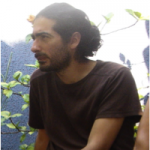Link to Pubmed [PMID] – 22877579
Link to DOI – 10.1016/j.neuroimage.2012.07.053S1053-8119(12)00783-5
Neuroimage 2012 Nov; 63(3): 1257-72
The description of cortical folding pattern (CFP) is challenging because of geometric complexity and inter-subject variability. On a cortical surface mesh, curvature estimation provides a good scalar proxy of CFP. The oscillations of this function can be studied using a Fourier-like analysis to produce a power spectrum representative of the spatial frequency composition of CFP. First, we introduce an original method for the SPectral ANalysis of GYrication (Spangy), which performs a spectral decomposition of the mean curvature of the grey/white interface mesh based on the Laplace-Beltrami operator eigenfunctions. Spangy produces an ordered 7 bands power spectrum of curvature (B0-B6) and provides an anatomically relevant segmentation of CFP based on local spectral composition. A spatial frequency being associated with each eigenfunction, the bandwidth design assumes frequency doubling between consecutive spectral bands. Next, we observed that the last 3 spectral bands (B4, 5 and 6) accounted for 93% of the analyzed spectral power and were associated with fold-related variations of curvature, whereas the lower frequency bands were related to global brain shape. The spectral segmentation of CFP revealed 1st, 2nd and 3rd order elements associated with B4, B5 and B6 respectively. These elements could be related to developmentally-defined primary, secondary and tertiary folds. Finally, we used allometric scaling of frequency bands power and segmentation to analyze the relationship between the spectral composition of CFP and brain size in a large adult dataset. Total folding power followed a positive allometric scaling which did not divide up proportionally between the bands: B4 contribution was constant, B5 increased like total folding power and B6 much faster. Besides, apparition of new elements of pattern with increasing size only concerned the 3rd order. Hence, we demonstrate that large brains are twistier than smaller ones because of an increased number of high spatial frequency folds, ramifications and kinks that accommodate the allometric increase of cortical surface.

